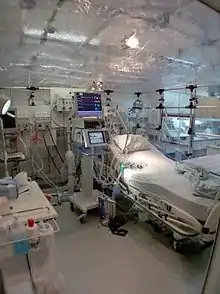Medical–industrial complex
The medical–industrial complex is the network of corporations which supply health care services and products for a profit. The term is analogous to "military–industrial complex" and builds from the social precedent of discussion on that concept.

The medical–industrial complex is often discussed in the context of conflict of interest in the health care industry.
Term
The concept of a "medical–industrial complex" was first advanced by Barbara and John Ehrenreich in the November 1969 issue of the Bulletin of the Health Policy Advisory Center in an article entitled "The Medical Industrial Complex" and in a subsequent book (with Health-PAC), The American Health Empire: Power, Profits, and Politics (Random House, 1970). The concept was widely discussed throughout the 1970s, including reviews in the New England Journal of Medicine (November 4, 1971, 285:1095). It was further popularized in 1980, Arnold S. Relman while he served as editor of The New England Journal of Medicine.[1] in a paper titled "The New Medical-Industrial Complex." Relman commented, "The past decade has seen the rise of another kind of private "industrial complex" with an equally great potential for influence on public policy — this time in health care..." Oddly, Relman added, " In searching for information on this subject, I have found no standard literature and have had to draw on a variety of unconventional sources..."[1] Subsequently, this paper and the concept have been discussed continually.[2] An updated history and analysis can be found in John Ehrenreich, "Third Wave Capitalism: How Money, Power, and the Pursuit of Self-Interest have Imperiled the American Dream" (Cornell University Press, May 2016).
Characteristics
Manufacturers of medical devices fund medical education programs and physicians and hospitals directly to adopt the use of their devices.[3]
The management of health care organizations by business staff rather than local medical practice is one of the trends of the increasing influence of the medical-industrial complex.[4]
Another trend is that increased pressure to generate profit for providing services can decrease the influence of creativity or innovation in medical research.[5]
In the 1970s profit-seeking companies became significant stakeholders in the United States healthcare system.[6]
The influence of economic policy on the practice of medicine has a long history.[7]
Because the General Agreement on Trade in Services regulates international marketplaces, in countries where the industrial-medical complex is more strong there can be legal limitations to consumer options for accessing diverse healthcare services.[8]
Because the industrial-medical complex funds continuing medical education, this education has a bias to promote the interests of its funders.[9]
References
- Relman, Arnold S. (1980). "The New Medical-Industrial Complex". New England Journal of Medicine. 303 (17): 963–970. doi:10.1056/NEJM198010233031703. ISSN 0028-4793. PMID 7412851.
- Malina, Debra; Rosenbaum, Lisa (2015). "Understanding Bias — The Case for Careful Study". New England Journal of Medicine. 372 (20): 1959–1963. doi:10.1056/NEJMms1502497. ISSN 0028-4793. PMID 25970055.
- Baggish, Michaels.; Nezhat, Camran (1992). "The Medical–Industrial Complex". Journal of Gynecologic Surgery. 8 (3): v–vi. doi:10.1089/gyn.1992.8.v. ISSN 1042-4067.
- Maloney, FP (1998). "The emerging medical/industrial complex. The industrialization of medicine". Physician Executive. 24 (2): 34–8. PMID 10180498.
- Stevens, CW; Glatstein, E (1996). "Beware the Medical-Industrial Complex". The Oncologist. 1 (4): IV–V. PMID 10388005.
- Buchanan, Robert J. (Winter 1982). "The Financial Status of the New Medical-Industrial Complex". Inquiry. 19 (4): 308–316. JSTOR 29771516.
- Jupiter, Jesse; Burke, Dennis (2013). "Scott's parabola and the rise of the medical–industrial complex". HAND. 8 (3): 249–252. doi:10.1007/s11552-013-9526-5. ISSN 1558-9447. PMC 3745238. PMID 24426930.
- Santos, MA; Passos, SR (August 2010). "[International trade in health services and the medical industrial complex: implications for national health systems]". Cadernos de Saúde Pública. 26 (8): 1483–93. doi:10.1590/s0102-311x2010000800003. PMID 21229208.
- Schofferman, Jerome (2011). "The Medical-Industrial Complex, Professional Medical Associations, and Continuing Medical Education". Pain Medicine. 12 (12): 1713–1719. doi:10.1111/j.1526-4637.2011.01282.x. ISSN 1526-2375. PMID 22145759.
Further reading
- Geyman, John P. (2004-01-01). The Corporate Transformation of Health Care: Can the Public Interest Still Be Served?. Springer Publishing Company. ISBN 9780826124678. Retrieved 2015-05-14.
- Schatman, Michael E. (2011). "The Medical-Industrial Complex and Conflict of Interest in Pain Education". Pain Medicine. 12 (12): 1710–1712. doi:10.1111/j.1526-4637.2011.01284.x. ISSN 1526-2375.
- Rosenthal, Elisabeth (2017). An American Sickness: How Healthcare Became Big Business and How You Can Take it Back. Penguin Press. ISBN 9780698407183.
